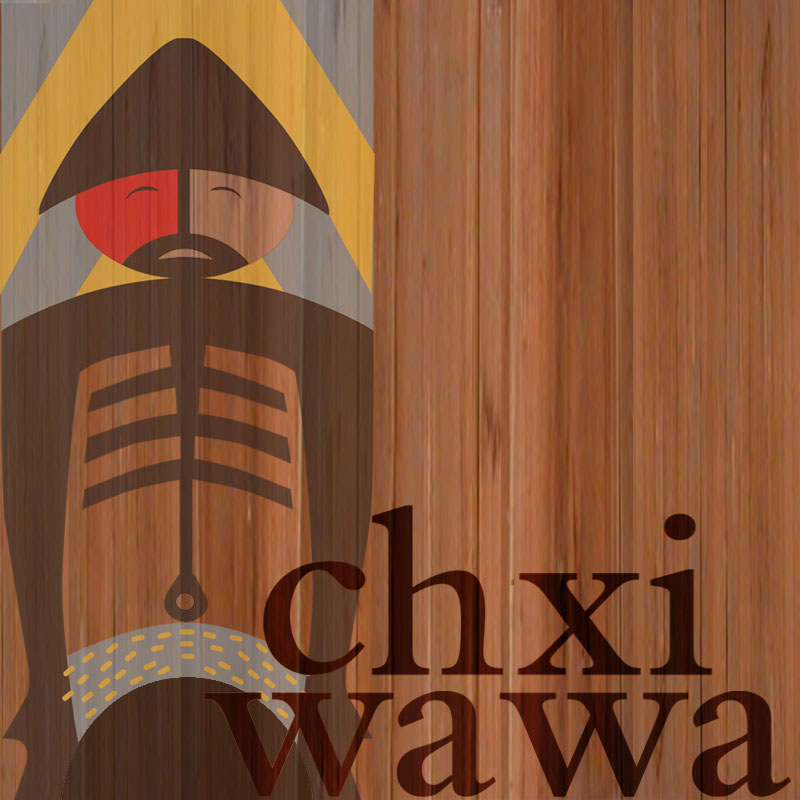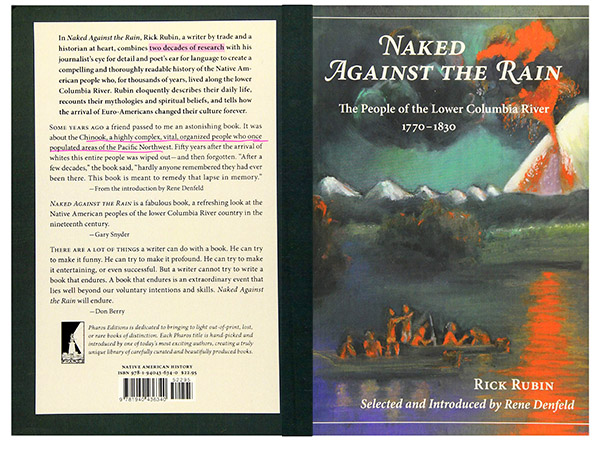Naked Against the Rain: The People of the Lower Columbia River, 1770-1830 by, Rick Rubin/Reviewed by Aaron Ero-Jones
We begin our series on educational resources with an early and often-encountered book, Naked Against the Rain, written by free-lance writer and columnist, Rick Rubin. Published in 1999, Rubin’s three hundred plus page ethnography focuses on a brief window in Chinookan history spanning roughly sixty years, with only a single chapter devoted to our history before the arrival of European settlers. While focusing mostly on the five tribal communities that make up the Chinook Indian Nation , Naked Against the Rain also examines the numerous other Chinookan speaking tribes that span Iyagaytɫ Imaɫ/The Columbia River.
Many of you might have encountered this work as your first text relating to our people’s history. I, myself, was an undergrad, recently transferred to the University of Washington from a small community college in Vancouver. Recently re-enrolled and living alone on Duwamish illahee, I was overwhelmed and desperate for knowledge of our ancestors and cultural heritage. I absorbed what I could from tribal elders and other prominent members at public events, but my isolation along the shores of the Salish Sea left me little opportunity to learn. Many of you may have felt the same at points in your life, a common symptom of a diasporic communities battered by colonial occupation. It was during this time that I stumbled upon Rubin’s then out of print ethnography, squirreled away in a small hole-in-the-wall bookshop. I was ecstatic (ecstatic enough to overlook the sixty-dollar price tag) and quickly dove in. Early into the first few chapters, my excitement evaporated.
Instead of a way for a young Chinook man to connect with his ancestors I discovered that Naked Against the Rain is most certainly written by and for the benefit of White settlers. I hardly made it further than the first few pages before I found myself feeling unwanted and uninvited. The dedication page, like a bouncer at a Portland nightclub, raised its hand saying, “For those who come after, to live beside Big River.” Those that ‘came before,’ should look somewhere else. The text that followed was no different.
Naked Against the Rain, though meticulously researched, features zero collaborative work with contemporary Chinookan members. Instead, Rubin positions himself as though he were the sole heir to Iyagaytɫ Imaɫ. His lengthy blurb on the book’s dust jacker reads,
“[Rubin] researched the world of the Chinook-speakers by reading everything written about them, canoeing their rivers, searching out their foods, reciting their myths, and meditating the meaning of their long existence and sudden passing.” A scouring of the books citations finds not a single reference to nation or tribal members. Nothing from Grand Ronde, Wasco/Wishram, Yakima, much less our own. One might be forgiven thinking Rubin were the sole remaining Chinook in the world.
Unfortunately, this was hardly unique for the time. In this way, Naked Against the Rain is no different than most works of the late 20th century that focus on Indigenous peoples. The late 1980s and most of 1990s saw an increased curiosity in the history of our ancestors by American settlers. Films like Dances with Wolves (1990), The Last of the Mohicans (1992), and Disney’s highly revisionist animated feature, Pocahontas (1995) captivated the American imagination, quickly becoming massive blockbusters and garnering critical accolades the world over. These films, though more sympathetic and less overtly racist, commonly portrayed Native figures and communities as bygone or dying communities. More importantly, it was the role of these Hollywood Native’s to ultimately transfer their knowledge and what Philip Deloria describes as the “Spirit of Place” to a White, typically male, figure before disappearing entirely.
I offer this history not as entertainment or fact, but instead as a tool for you to use. White settlers often encode their works with their own desires and ways of knowing. For over a century, they have subsumed, stolen, and rewritten our histories all the while building their own sense of authority over our communities. Their history is twisted up in their accounts of our own, making them difficult to untangle. I think of my time fishing on Iyagaytɫ Imaɫ or the Wasixgwol, of the times when the spool of my fishing reel spun too quickly, bunching my fishing line into a knotted bird’s nest. When I read Naked Against the Rain, I think of my time pulling out the those tangled loops of line, hoping to salvage my day on the water.
Much like this, finding value in untangling these works can prove difficult, but it is possible and sometimes rewarding. Rubin’s voice and writing are incredibly accessible even at times lyrical. Large portions of Naked Against the Rain read more like a novel than a work of history. I frequently found myself lingering on these sections as his descriptions of everyday life in our villages and communities can be valuable, if not entrancing. Chapters 3 and 7 prove good examples of Rubin’s vivid style in presenting valuable research. “Chapter 14: The Bahsten Make a Fort” provided one of my favorite moments of analysis when Rubin concludes, “The word ‘Indian’ continually came between the Astorians and reality.” (203)
However, this easily accessible writing gets Rubin into a lot of trouble as well. The tone in many chapters can be flippant or dismissive, which can be upsetting when analyzing sensitive topics. His penchant for storytelling often leads to heavy amounts of generalization and speculation bordering on fiction. Some examples lie in generalizations like “the Chinook were expert petty thieves and liars,” (70) or “Thus was she raised a princess, and indeed she was a princess,” (176). These statements often appear without any source to speak of and seem straight out of a White settler dream rather than historical record. Rubin goes so far as to blatantly generalize Chinookan languages as, “sound[ing] a great deal like all the other languages of the Northwest coast.” (51). One section in “Chapter 17: The Kin Chautch Make a War 1814” sees Rubin admit a blatant preference for outright fantasy than historical fact. “There is no evidence whatsoever,” Rubin ponders. “But it would solve a couple of problems, and it makes a better story.” (251).
His penchant for sensationalism also causes Rubin to frequently contradict himself or undermine his credibility entirely. In “Chapter 8: What Coyote Did in this Land”, Rubin states without evidence that ikanem were “exactly recited” (108) but soon after states, “The teller shaped the story by his or her interpretation.” (108-109). Another example in “Chapter 4: Chinook as They Spoke it”, proves highly suspicious. In it, Rubin describes numerous elements of the Chinook languages, but mistakenly applies gendered pronouns instead of non-gendered ones. Chinuk Wawa, receives similar treatment in a later chapter with numerous misspellings. More troubling, Rubin cites a highly racist remark from ethnographer, Franz Boaz, on pg. 55 that he accepts entirely without disagreement and later uses as a foundation for his own analysis on pg. 108. In many cases, entire chapters must be read carefully and skeptically. Sections in Chapter 15 on gender norms should be especially scrutinized and taken with a grain of salt. Similar such remarks make frequent appearances throughout the text. In spite of these problems, many chapters still provide valuable accounts and information, if readers remain careful with what they accept as fact.
I preface this, however, to prepare readers for the main problem regarding Naked Against the Rain: an ethnography of a vibrant, complex community as nothing more than scintillating grim entertainment. Ikanem are described mostly without credit to community or tribal ownership, and with no regard to the time of season in which it is told. Our illahee is presented like the stereotypical paradise of the settler imagination, with our farming and biome management largely unmentioned. However, Rubin saves his most blatant and inappropriate afront for the final chapter. Turning the page upon the last section readers are greeted with a large black and white photo of the skull of Tyee Comcomly. I slammed the book closed. As Chinook we are taught to be cautious around the dead. One must not stay overnight in a graveyard or stare at the fog that hangs above our trees or moves across the water. To do so would risk our own safety. These thoughts ran through my head as I tried to unsee the image Rubin had so carelessly thrown on the page. But most of all I tried to overcome the grief and pain the image shot through my heart, because, due to the carelessness of a White settler, I had been forced to witness the severed head of my own 7th great-grandfather.
I tell you this because Rubin does this several times throughout the text. He continually titillates his White readers by portraying us as doomed, tragic figures fit for a Shakespearian tragedy. His intriguing depictions of our community become double-edged swords through the addition of lines like, “but one wonders whether even their most prescient seers could guess they had only a decade left to enjoy their rain-gladdened riverside Eden.” (297). In this way, Rubin passes on his greatest disguise: a colonial ghost story under an ethnography’s clothing. For Rubin, we are a race of ghosts come to haunt the edges of the settler mind. There is no allowance for a Chinookan reader. No consideration for displaying the remains of our ancestors even after Rubin, himself, describes the taboos surrounding such an act. To Rubin, he and his White readers are the new Chinooks. He says so, himself, on page. 373 claiming, “Tsagiglalal had seen it all…She watches still, but now she watches us.” Worse yet, Rubin goes to great lengths to hide our contemporary status and vibrant survival. Instead, he cruelly remarks that, “[S]urely the dead of August 1830 were fortunate…They did not linger to suffer the humiliation of living in little shacks and being sent to jail.” (374).
Final Verdict:
Naked Against the Rain offers intriguing accounts and information presented in an accessible and, at times, addictive way. However, the book is laced with sensationalized drama aimed at a White settler audience. Rubin at times displays an utter disregard for our culture and survivance, that fuels stereotypes and misinformation that persists to this day. For well informed readers that are privileged with access to tribal elders and leaders, this book can prove helpful, but remains dangerous for members early into their attempts at decolonization. You can untangle Naked Against the Rain if you wish to put in the effort, but we have survived without it.








